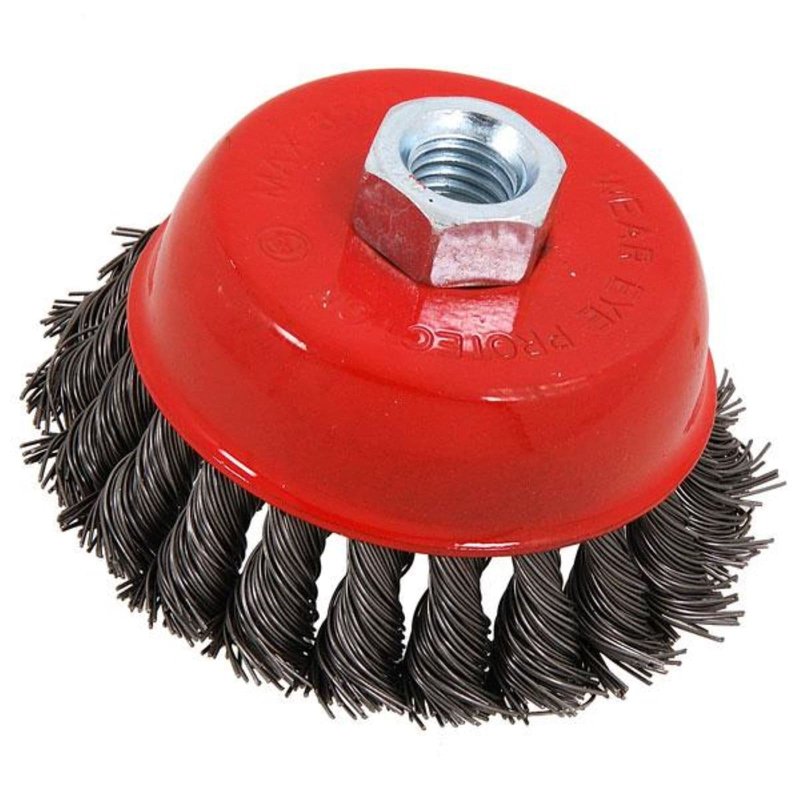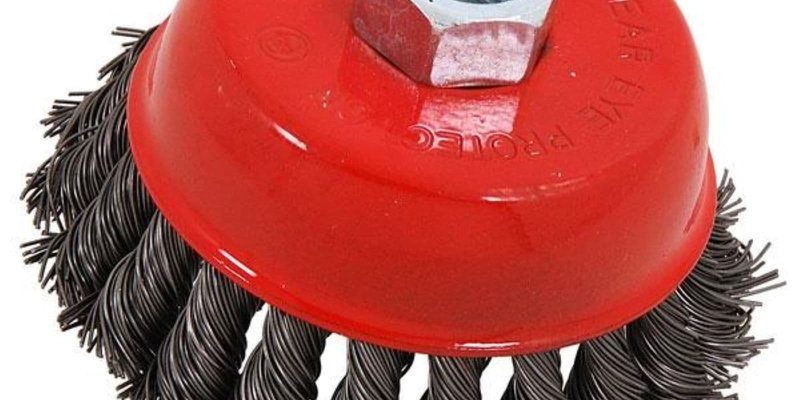
Honestly, if you want to tackle aggressive rust removal on anything from auto parts to railings, a wire wheel brush is hard to beat. Brands like DEWALT, Makita, and Milwaukee all make wire wheels designed to mount on common power tools, and they come in various shapes and sizes. The trick is knowing how to use them safely and effectively—because with great spinning power comes some responsibility (and flying debris). So, before you grab your drill and attack that rusty bolt, let’s break down exactly how to get pro-level results, even if you’re a total beginner.
What Is a Wire Wheel Brush—and Why Use One for Rust?
A wire wheel brush is pretty much what it sounds like: a wheel made up of stiff metal wires clustered around a hub, meant to be spun at high speeds. When attached to a drill or grinder, those wires whip around and scrape away at the surface of metal. It’s like using hundreds of tiny steel fingers to scratch off rust and paint all at once—fast, noisy, and incredibly effective.
Here’s the thing: rust doesn’t just sit on top of metal. It bites in and flakes, so you need something aggressive to lift it out of nooks and crannies. While you could try sandpaper or even a regular brush, they won’t do much on thicker, crustier rust. A wire wheel brush, especially a hardened steel version from a brand like DEWALT, syncs perfectly with power tools to blast away even the toughest spots.
You might be wondering why not use chemicals instead. In some cases, chemicals can help, but they’re messy, sometimes dangerous, and often leave residue. A wire wheel brush is simple, reusable, and doesn’t rely on anything but elbow grease (and maybe a steady drill battery). Plus, you get instant visual feedback—the more you brush, the brighter and cleaner the metal looks underneath.
Types of Wire Wheel Brushes and When to Use Each
Not all wire wheel brushes are built the same, and picking the right type can make rust removal safer and easier. Most hardware stores stock two main shapes: cup brushes and wheel brushes. Both attach to drills or grinders, but they work a bit differently on surfaces.
- Wheel brushes look like a flat disc and are best for broad, flat surfaces. Think: cleaning up a lawnmower blade or the side of a metal toolbox.
- Cup brushes resemble a little metal bowl with bristles sticking out. These are great for covering wider areas like a rusty gate or for getting into grooves where wheels can’t reach.
- End brushes are smaller and made for tight spots—inside corners, crevices, or awkward bolt heads.
There’s also a difference between crimped wires (wavy, flexible, better for light to medium rust) and knotted/twisted wires (stiffer, much more aggressive, meant for heavy-duty jobs). Honestly, if you’re dealing with thick, flaky, or deeply pitted rust, go for a knotted wire brush from a reliable brand like Makita. For lighter touch-ups or prepping shiny surfaces without gouging, a crimped wire does the trick.
One more thing—match the brush to your tool. Most wheel brushes fit angle grinders, but you’ll also find versions that attach directly to a cordless drill. Always check the shank size and recommended max RPM (rotations per minute), so you don’t accidentally damage your brush or tool.
Essential Safety Gear and Prep Work
Wire wheel brushes are amazing for aggressive rust removal, but they’re not exactly gentle. The wires can fling off tiny sharp bits of rust, and sometimes even break loose. That means safety gear isn’t optional—it’s absolutely essential.
- Eye protection: Wear safety goggles, not just glasses. Rust and metal bits can fly in weird directions.
- Gloves: Heavy-duty work gloves protect your hands from sharp wires and accidental slips.
- Dust mask or respirator: Rust dust isn’t good for your lungs. A mask helps you avoid breathing in debris, especially when working on painted or dirty metal.
- Ear protection: Power tools get loud, especially when crunching through corrosion. Earplugs or muffs help here.
Before you even touch the brush to metal, prep your workspace. Clamp down whatever you’re cleaning so it won’t spin away. If you’re using a corded drill or grinder, make sure you have enough slack on your power cord or extension to avoid any sudden tugs. And honestly, make sure you have good lighting—you’ll want to see the difference between clean metal and the spots you still need to work on.
How To Attach and Set Up Your Wire Wheel Brush
Attaching a wire wheel brush seems straightforward, but there are some details to get right. First, always unplug or remove the battery from your drill or angle grinder before handling any accessory. Safety first, every single time.
If you’re using a drill, choose a wire wheel with a shank that fits your chuck (usually either 1/4″ or 3/8″). Open the chuck, insert the shank, and tighten it down snugly. Give it a gentle tug to make sure it’s locked. For an angle grinder, pick a brush with the correct arbor size. Unscrew the grinder’s guard and disc, slip on the brush, and tighten everything according to the tool’s instructions.
Don’t forget to reattach any guards or shields that came with your tool. They’re there for a reason. Before you start, hold the brush away from your project and give it a quick spin at low speed to check for wobbling, loose wires, or odd vibrations. If the brush looks uneven, reset or replace it before going any further. Sometimes, cheap universal brushes don’t sync perfectly with every model—higher-end brands tend to have smoother fit and finish.
Step-By-Step: Removing Rust With a Wire Wheel Brush
Let me walk you through how to actually use a wire wheel brush for aggressive rust removal, so you get smooth, shiny results without damage or frustration.
- Secure the item: Use a vise or sturdy clamp to hold your metal piece steady. This makes the job safer and way less tiring.
- Set drill/grinder speed: Start at a medium speed. Too fast, and the brush could kick back; too slow, and you won’t get deep rust off.
- Apply gentle pressure: Let the spinning wires do the work—you don’t need to shove the brush into the metal. Move steadily across the rust, overlapping your strokes so you don’t miss spots.
- Watch for heat: If the area gets hot to the touch, take a break. Overheating can warp thinner metals or even mess with painted surfaces nearby.
- Check your progress: Wipe away debris occasionally to see if you’ve stripped all the rust, or if a little more time is needed.
Here’s the thing: if you hit a tough spot and nothing happens, don’t just push harder. It might be time to switch to a more aggressive knotted wire, or try a different angle. Also, keep the brush moving—lingering in one place for too long makes grooves or shiny “burn” marks on your steel.
Common Problems and How To Troubleshoot Them
Sometimes rust removal doesn’t go as planned, even with a powerful wire wheel brush synced up to a brand new drill. Maybe the brush keeps clogging up, or you notice the rust just isn’t coming off as smoothly as you hoped. Don’t worry; you’ve got options.
- Brush not cutting: If you feel like you’re just polishing the rust, check that your tool’s speed is high enough. Slow speeds make the wires skate over the surface instead of digging in.
- Brush loses wires: This happens with cheap universal brushes or if you’re pressing too hard. Back off the pressure. If wires are flying off fast, replace the brush—broken wires don’t just reduce performance, they’re dangerous.
- Rust reappears fast: Bare metal rusts again quickly, especially if you leave fingerprints or moisture on it. Wipe down your work with a clean, dry cloth and consider sealing with paint or a rust inhibitor.
- Tool gets hot or stalls: Check your battery if you’re using a cordless tool. Sometimes, extended use drains the battery much faster than normal drilling or driving. Let both tool and brush cool off if needed.
Sometimes, aggressive rust removal just needs a little patience. Don’t expect perfection in thirty seconds—slow, steady passes almost always give you a better, more even finish.
Comparing Wire Wheel Brushes to Other Rust Removal Methods
You might be asking, “Why not just use a sandblaster, chemical rust remover, or even a grinder disc?” Great question. Each has its place, but wire wheel brushes offer a sweet spot for many DIYers and pros alike.
- Sandpaper: Works on light surface rust, but it clogs fast and struggles with deep pitting. Plus, your arm will hate you after a few minutes.
- Chemical rust removers: Effective but messy, sometimes toxic, and can leave behind residue that must be neutralized before painting or welding.
- Angle grinder discs: Strips everything—including good metal—very quickly. Easy to gouge your piece or take off too much material, especially if you’re still learning.
- Sandblasting: Fantastic results, but requires special setup, a big compressor, and lots of cleanup. Overkill for most small projects.
Honestly, a wire wheel brush (especially from a trusted brand like Milwaukee or DEWALT) delivers the best mix of speed, control, and convenience for aggressive rust removal on everyday items. You can sync up a wire wheel to your favorite drill or angle grinder and reset the working surface in a matter of minutes.
How To Care for Your Wire Wheel Brush for Long-Lasting Performance
A worn-out or damaged wire wheel isn’t just ineffective—it can be risky. Maintaining your brush doesn’t take much extra work, but it makes a big difference in results and safety.
First, always inspect your brush before and after each use. Look for broken, bent, or missing wires. If the brush is more than about 30% worn down or starts shaking even after you reset it in the chuck, it’s time to replace it.
Store your brushes in a dry spot, away from moisture or humidity. Rust can attack your tools as well—ironic, right? If you use a universal brush with multiple tools, check the shank or arbor for signs of wear. And honestly, don’t push your brush beyond its rated speed or use it on materials it wasn’t designed for (like hard stone or plastic). Most higher-end brushes will list max RPM right on the packaging.
Too many people forget to clean their wire wheels after each use. A quick blast with compressed air or a stiff brush will knock loose the built-up rust and keep the wires free for next time. Treat your wire wheel brush with a little respect and it’ll make rust removal easier, safer, and a lot more satisfying.
Final Thoughts: Getting the Best Out of Aggressive Rust Removal
Using a wire wheel brush for aggressive rust removal is kind of like hitting the reset button on your old metal gear. It’s fast, effective, and oddly satisfying when those orange, crusty layers turn into shiny, smooth steel. The key is picking the right brush for the job, using your power tool safely, and going slow enough to avoid mistakes. Whether you’re working with a big-name DEWALT brush on a cordless drill or a universal cup brush on your angle grinder, taking time with your setup pays off.
Remember, rust never sleeps—but with a good wire wheel brush and a little know-how, you can stay one step ahead. So next time you spot a patch of stubborn rust, you’ll know exactly how to deal with it—safely, quickly, and with way less frustration.
